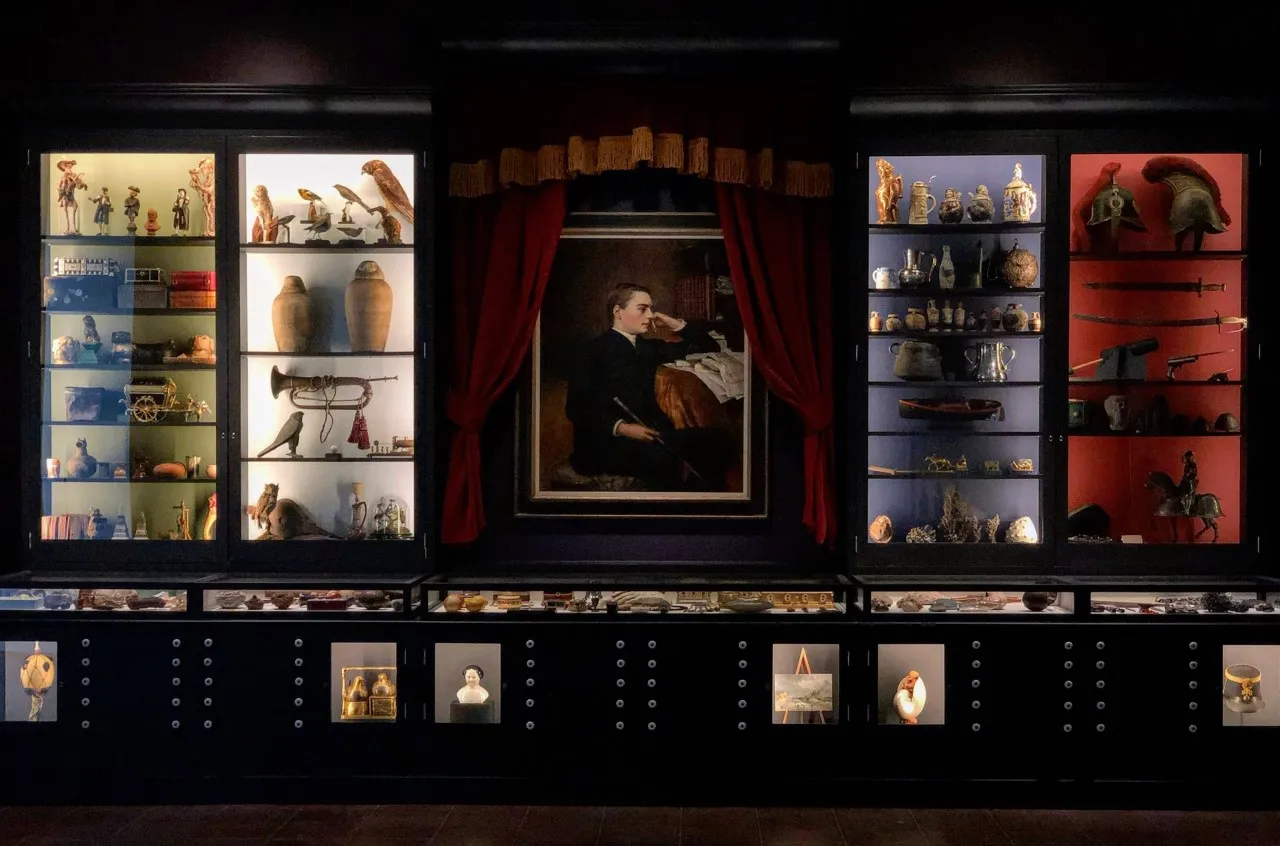As I walked into the dimly-lit exhibition, the echoes from Cantor’s atrium faded away. The midnight purple walls stood in stark contrast to the white marble hall leading up to “The Melancholy Museum: Love, Death, and Mourning at Stanford,” creating an immediate and immersive change in mood. I was struck by the sheer scale of the black Victorian mourning cabinet before me, packed with hundreds of weathered artifacts from the Stanford Family Collections. This exhibition of over 700 objects was curated by Mark Dion to tell the story of the Stanford family and their museum.
According to the exhibit’s wall text, Leland and Jane Stanford founded the Leland Stanford Junior Museum in 1894, 10 years after Leland Junior died just two weeks shy of his sixteenth birthday. In 1906, the San Francisco earthquake destroyed three-quarters of the museum and in 1989 the Loma Prieta earthquake resulted in further destruction. “When the museum reopened in 1999 … it had suffered more than a century of sorrow and devastation.”
A large portrait of Leland Stanford Junior immediately caught my eye. It was framed by blood-red curtains and situated above the middle of the mourning cabinet. This central section represented the “underworld,” Leland Junior’s final resting place, and its most symbolic artifacts were timepieces, such as an hourglass and multiple watches. The portrait was flanked by four other display cases — two on each side — which each represented one of the four elements: earth, air, water and fire.
The backing of each cabinet was color-coded accordingly; earth was green, air was white, water was blue and fire was red. The earth case housed stones and carved figurines. The air case had taxidermy birds, fans and pipes. The water case contained vessels, petrified sea fauna and shells. The fire case showcased mostly relics of war, from spearheads to bullets, from an axe the size of my finger to a sword that spanned the entire display case. Below the display cases were interactive drawers that invited the viewer to engage more intimately with the exhibit while offering the possibility of surprise; I was unsettled by the mummy of a crocodile that seemed extraordinarily shriveled in an otherwise empty drawer. Death seemed to permeate the entire space.
Across the hall was the other half of the exhibit, referred to as “The Gilded Age,” containing items that were organized into sections titled photography, stock farm, afterlife, laborers and railroad. The artifacts were displayed in a glass case embedded in the wall that encircled the entire room, interrupted only by an immense painting that depicted a lively gathering on a vibrant lawn. This painting was opposite the mourning cabinet, and the juxtaposition of its vivacious scene with the morbid display across the hall was striking.
Perhaps the most iconic artifact in “The Gilded Age” room was “The Last Spike,” or “Golden Spike,” which Leland Stanford drove into a pre-drilled hole to link the Central Pacific and Union Pacific railroads, creating the First Transcontinental Railroad in 1869. Equally as powerful, but substantially more haunting, were the death masks of Leland Stanford Senior, Leland Stanford Junior and Jane Stanford. The perfectly white flesh of the masks exaggerated their unsettling detail; I could imagine Leland Stanford Junior’s clumpy eyelashes fluttering open at any moment.
This exhibit was created, in part, to capture the curiosity of Leland Stanford Junior and his passion for collecting. The expansive scope of Leland Junior’s collection truly led me to believe that he would be proud to see the legacy of intellectual vitality that he has left behind in modern Stanford culture. “The Melancholy Museum: Love, Death, and Mourning at Stanford” is a must-see exhibit for anyone who shares this earnest curiosity.
The Stanford Family collection is a permanent fixture of the Cantor, but its existence as “Melancholy Museum” is temporary, so visit soon! The Cantor Arts Center is free for everyone and open every day of the week (except Tuesdays, when they’re closed, and Thursdays, when they’re open until 8 p.m.) from 11 a.m. to 5 p.m. Additionally, Stanford students can attend Cantor’s “First Fridays,” when “on the First Friday of every month during the academic year, the Cantor is open late for art-making, music, and more.” The next First Friday is on Oct. 4 from 7-10 p.m. It is free for anyone with an SUID.
Contact Dax Duong at daxduong ‘at’ stanford.edu.
